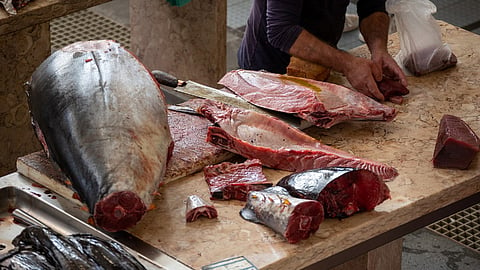Report shows 88 per cent of global tuna catch comes from stocks at healthy levels
Of the total commercial tuna catch worldwide, 88 per cent comes from stocks at “healthy” levels of abundance, according to the November 2024 International Seafood Sustainability Foundation (ISSF) Status of the Stocks report, marking an improvement of two percentage points compared to previous March 2024 report findings.
Overfished stocks account for 10 per cent of the total catch — unchanged from the last report. The percentage of the catch that came from stocks at an intermediate level of abundance decreased from four per cent — as reported in March 2024 — to two per cent.
Changes in stock status ratings since the March 2024 report include:
Abundance or “spawning biomass” (SSB) and exploitation rate or fishing mortality (F) ratings for Eastern Pacific Ocean bigeye improved from yellow to green.
Pacific Ocean bluefin’s F rating also improved from yellow to green.
SSB and F ratings for Atlantic Ocean Mediterranean albacore changed from orange to yellow. However, there is high uncertainty about the stock status due to poor monitoring and basic fishery statistics.
According to the November 2024 report, the below tuna stocks are considered overfished and/or subject to overfishing:
Indian Ocean bigeye and Indian Ocean yellowfin stocks are overfished and subject to overfishing, unchanged since the March 2024 report.
Pacific Ocean bluefin is overfished, also unchanged since the March 2024 report.
In terms of Regional Fisheries Management Organisations (RFMO) stock management, key updates since March 2024 include the following:
The Indian Ocean Tuna Commission (IOTC) adopted a new management procedure for skipjack tuna that will help reverse overcatch and ensure the long-term sustainability of the species.
The IOTC and the Inter-American Tropical Tuna Commission (IATTC) released updated fish aggregating device (FAD) measures, helping to improve how FADs are used and managed, reducing the impacts of FADs on the ecosystem, and increasing monitoring of these devices at sea.
ISSF publishes its Status of the Stocks report several times yearly using the most current scientific data on 23 major commercial tuna stocks. Related infographics for the November 2024 report are available here and here.
Key statistics in the new Status of the Stocks report
Abundance or SSB levels: Globally, 65 per cent of the stocks are at a healthy level of abundance — an improvement of four percentage points since the March 2024 report. Additionally, 13 per cent of the stocks are overfished — marking a decrease of four percentage points since the previous report. Unchanged since the March 2024 report, 22 per cent are at an intermediate level.
Fishing mortality levels: 87 per cent of the 23 stocks are not experiencing overfishing — an improvement of nine percentage points from the March 2024 report. Nine per cent are experiencing overfishing — a four-percentage-point decrease since the previous report. Also, four per cent are at an intermediate level — a five-percentage-point reduction since March 2024.
Tuna production by fishing gear: 66 per cent of the catch is made by purse seining, followed by longline (nine per cent), pole-and-line (eight per cent), gillnets (three per cent) and miscellaneous gear (14 per cent).
Largest tuna catches by stock: The five largest catches in tonnes — all unchanged since the previous report except for Eastern Pacific Ocean skipjack — are Western Pacific Ocean skipjack, Western Pacific Ocean yellowfin, Indian Ocean skipjack, Indian Ocean yellowfin, and Eastern Pacific Ocean skipjack. In the March 2024 report, Eastern Pacific Ocean yellowfin was amongst the five largest tuna catches by stock.
Total catch: The catch of major commercial tunas was 5.2 million tonnes in 2022, a two per cent increase from 2021. Fifty-seven percent of it was skipjack tuna, followed by yellowfin (30 per cent), bigeye (seven per cent) and albacore (five per cent). Bluefin tunas accounted for one per cent of the global catch.
The Status of the Stocks report is reviewed by the ISSF Scientific Advisory Committee (SAC), which provides advice on its content. The report does not advocate any particular seafood purchase decisions.


